| CHAPTER III: LIBRARIES OF THE GREAT ABBEYS—BOOK-LOVERS AMONG THE
MENDICANTS—DISPERSAL OF MONKISH LIBRARIES Old English libraries; the making, collection and use of books during the middle ages | ||
3. CHAPTER III: LIBRARIES OF THE GREAT ABBEYS—BOOK-LOVERS AMONG THE MENDICANTS—DISPERSAL OF MONKISH LIBRARIES
1. § I
THE Conquest wrought both good and evil to literature —evil because the Normans thought books written in the vernacular unworthy of preservation;[3.1] good because the change brought to the country settled government, and to the church an opportunity for reformation. Lanfranc was the moving spirit of reform, both in church administration and in the learning of its members. While still in Normandy he had built up a reputation for the monastic school at Bec, and probably had a share in collecting the excellent library that we know the monastery possessed in the twelfth century. [3.2] When he was appointed to the see of Canterbury he continued to work for the same
Lanfranc also encouraged original composition, for Osbern, monk of Canterbury, compiled his lives of St. Dunstan, St. Alphege, and St. Odo under his eye.
In this work of bookmaking and collecting Lanfranc was supported or his example was followed by other monks from Normandy: by Abbot Walter of Evesham, who made many books;[3.6] by Ernulf of Rochester, who compiled the Textus Roffensis; and by many others. At this time grew up the practice of using English houses to supply books for Norman abbeys; this partly explains the number of manuscripts of English workmanship now abroad. A manuscript preserved in Paris contains a note by a canon of Ste-Barbe-en-Auge referring to Beckford in Gloucestershire, an English cell of his house, whence books were sent to Normandy.[3.7]
From Lanfranc to the close of the thirteenth century, was the summer-time of the English religious houses. The
During this prosperous age some of the great houses did their
best work in writing and study. Thus to pick out one or two facts from a
string of them. In 1104 Abbot Peter of Gloucester gave many books to the
abbey library. In 1180 the refounded abbey of Whitby owned a fair
library of theological, historical, and classical books.
[3.10] About the same time Abbot Benedict ordered
the transcription of sixty volumes, containing one hundred titles, for
his library at Peterborough.[3.11] By 1244,
in spite of losses in the fire of 1184, Glastonbury had a library of
some four hundred volumes, historical books consorting with romances,
Bibles and patristical works almost crowding out some forlorn
classics.[3.12] Nearly half a century later
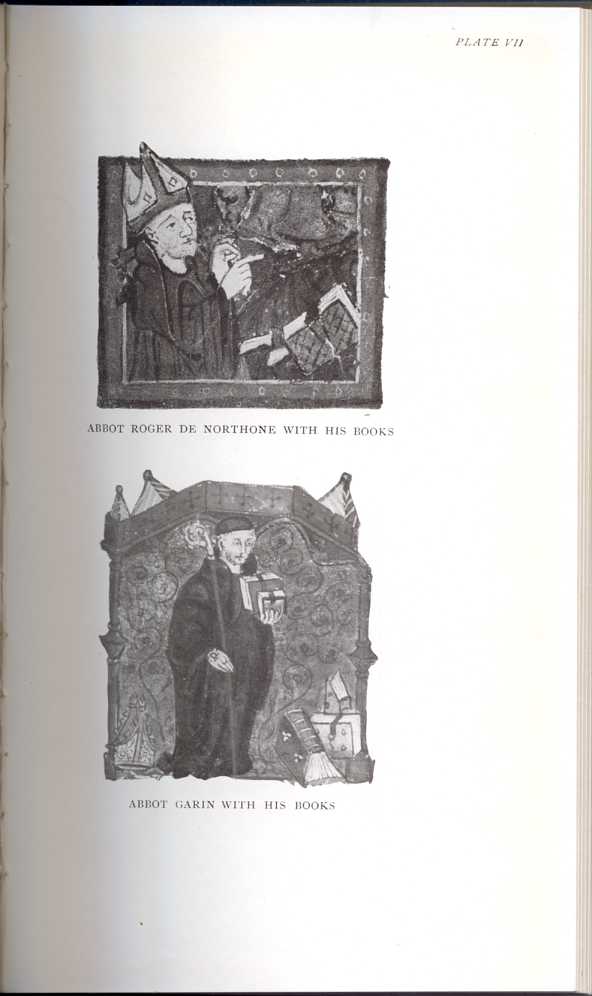 [Description: ABBOT ROGER DE NORTHONE WITH HIS BOOKS;
ABBOT GARIN WITH HIS BOOKS]
[Description: ABBOT ROGER DE NORTHONE WITH HIS BOOKS;
ABBOT GARIN WITH HIS BOOKS]
To such facts as these should be added the record of the Canterbury, Dover, and Bury libraries, the histories of which have been so admirably written by Dr. M. R. James. [3.15] Of the library of St. Albans Abbey we have not such a fine series of catalogues. Yet no abbey could have a nobler record. From Paul (1077) to Whethamstede (d. 1465) nearly all its abbots were book-lovers.[3.16] Paul built a writing-room, and put in the aumbries twenty-eight fine books (volumina notabilia), and eight Psalters, a Collectarium, books of the Epistles and Gospels for the year, two copies of the Gospels adorned with gold and silver and precious stones, without speaking of ordinals, customaries, missals, troparies, collectaria, and other books. Here, as everywhere, the library began with church books: later, easier circumstances made the stream of knowledge broader, if shallower. The next abbot also added some books. Geoffrey, the sixteenth abbot, was the author of a miracle play, an industrious scribe, and the donor of some books finely illuminated and bound. His successor, at one time the conventual archivist, loved books equally well, and got together a fair collection. Great Abbot Robert had many books written—"too many
John, worthy follower of Simon, was a man of learning, who added
many noble and useful books to St. Albans' store. William of Trompington
(1214) distinguished himself by giving to the abbey books he had taken
from his prior. Abbot Roger was a better man, and gave many books and
pieces; but John III and IV and Hugh are barren rocks in our fertile
valley, for apparently they did nothing for the library. Richard of
Wallingford did worse than nothing. He bribed Richard de Bury with four
volumes, and sold to him thirty-two books for fifty pounds of silver,
retaining one-half of this sum for himself, and devoting the other
moiety to Epicurus—"a deed," cries the chronicler, "infamous to all who
agreed to it, so to make the only nourishment of the soul serve the
belly, and upon any account to apply spiritual dainties to the demands
of the flesh."[3.18] Abbot Michael de
Mentmore, who had been educated at Oxford, and became schoolmaster at
St. Albans, encouraged the educational work of the abbey by making
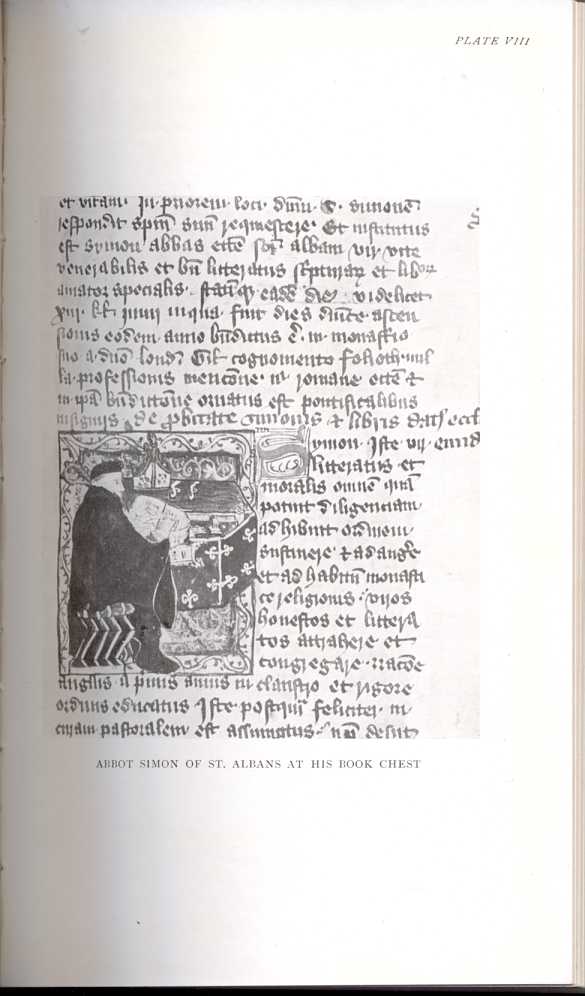 [Description: ABBOT SIMON OF ST. ALBANS AT HIS BOOK
CHEST]
[Description: ABBOT SIMON OF ST. ALBANS AT HIS BOOK
CHEST]
But Whethamstede was St. Albans' greatest book-loving abbot. An ardent book-lover, especially fond of finely-illuminated volumes, he indulged his passion for manuscripts, and for conventual buildings, vestments, and property, until he got the abbey into debt, and was led to resign. After the death of his successor, Whethamstede was re-elected. In his time no fewer than eighty-seven volumes were transcribed.[3.19] In 1452-53 he built a new library at a cost of more than £150. Another library was erected for the College of the Black Monks at Oxford, for £60. [3.20] It was described as a "new erection of a library joyning on the south-side of the chapel, containing on each side five or more divisions, as it may be partly seen to this day by the windows thereof, to which he gave good quantity of his own study, and especially those of his own composition, which were not a few, and to deter plagiaries and others from abusing of them, prefixt these verses in the front of every one of the same books, as he did also to those that he gave to the publick library of the University:
Per patrem pecorum prothomartyris Angligenarum;
Quem, si quis rapiat raptim, titulumve retractet,
Vel Judae laqueum, vel furcas sentiat; Amen
"In other books which he gave to the said library these:
Culta magisque Deae datur hic fiber ara Minervae,
His qui Diis dictis libant holocausta ministris
Et circa bibulam sitinnt prae nectare limpham
Estque librique loci, idem dator, actor et unus." [3.21]
This, in brief, is the story of St. Albans' tribute to learning. In most monasteries the same kind of work went on, in a more circumscribed fashion, and without the same distinction of finish, which could probably only be attained at the big places where expert scribes and illuminators could be well trained.[3.22]
2. § II
Fortunately, just when the great houses had attained the summit of their prosperity, and were beginning the slow decline to dissolution, learning and book-culture were freshly encouraged by the coming of the Friars.
The Black Friars settled at Canterbury and in London, near the Old Temple in Holborn, in 1221. The Grey Friars were at London, Oxford, and Cambridge in 1224, and by 1256 they were in forty-nine different localities.[3.23] lt is strange how the latter order, founded by a man who forbade a novice to own a Psalter, came to be as earnest in buying books as the Benedictines were in copying them. St. Francis' ideal, however, was impossible. The peripatetic nature of their calling, and their duty of tending the sick, compelled many friars to learn foreign languages, and to acquire some medical knowledge. Books were, therefore,
By the end of the thirteenth century the Mendicants of Oxford were fairly well provided with books. Michael Scot came to Oxford, at the time of the greatest literary activity of the brethren, and introduced to them the physical and metaphysical works of Aristotle (1230).[3.26] Adam de Marisco seems to have been responsible for the first considerable additions to the collection. From his brother, Bishop Richard, he had already received a library; possibly this, with his own books, came into possession of the convent. Then out of love for him, Grosseteste left his writings or his library—it is not clear which—to the Grey Friars. [3.27]
The White Friars also had a library at Oxford, wherein they garnered the works of every famous writer of their order. They are praised for taking more care of their books than the brethren of other colours.[3.29] In later times, at any rate, some cause for the complaint against the Grey Friars existed. They appear to have sold many manuscripts to Dr. Thomas Gascoigne (c. 1433). He ultimately gave them to the libraries of Lincoln, Durham, Balliol, and Oriel Colleges. As the friars' mode of life grew easier and the love of learning less keen, they got rid of many more books. In Leland's time the library had melted away. After much difficulty he was allowed to see the book-room, but he found in it nothing but dust and dirt, cobwebs and moths, and some books not worth a threepenny piece.[3.30]
Roger de Thoris, afterwards Dean of Exeter, presented a library
to the Grey Friars of his city in 1266.
[3.31] What became of it we do not know. About the
same time, in 1253 to be exact, the will of Richard de Wyche, Bishop of
Chichester, is notable for its bequests to the friars; thus he left
books to various friaries of the Grey Brethren—at
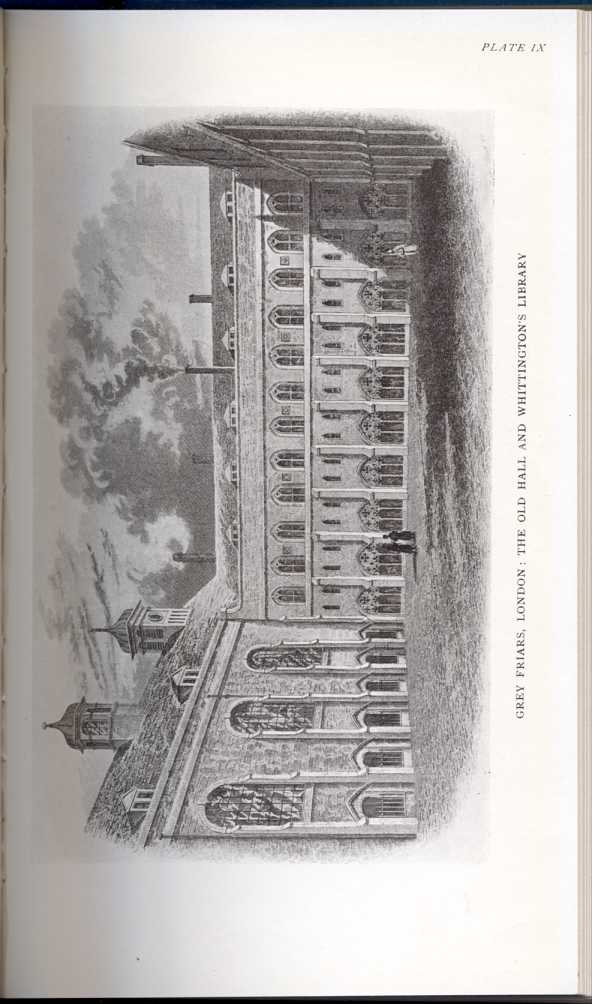 [Description: GREY FRIARS, LONDON: THE OLD HALL AND
WHITTINGTON'S LIBRARY]
[Description: GREY FRIARS, LONDON: THE OLD HALL AND
WHITTINGTON'S LIBRARY]
The friary collections in London seem to have been important, especially that given to the Grey Friars in 1225, [3.33] just when they had settled near Newgate. The Austin Friars may have owned a library before 1364, when two of their number left the London house, taking with them books and other goods.[3.34] Early in the fifteenth century a library was built and a large addition was made to the books of this house by Prior Lowe, a friar afterwards occupying the sees of St. Asaph and of Rochester.[3.35] At this time the friars of London were specially fortunate. The White Friars enjoyed a good library, to which Thomas Walden, a learned brother of the order, presented many foreign manuscripts of some age and rarity. [3.36] The Grey Friars' library was founded or refounded by Dick Whittington (1421).[3.37] The room "was in length one hundred twentie nine foote, and in breadth
Of few of the friary libraries have we definite knowledge of their size and character. But in the case of the Austin Friars of York, a catalogue of their library is extant. The collection was a notable one. The inventory was made in 1372, and the items in it, forming the bulk of the whole, with some later additions, amounted to 646. One member of the society named John Erghome was a remarkable man. He was a doctor of Oxford, where he had studied logic, natural philosophy, and theology. More than 220 books were his contribution to this splendid library, and he it was who added the Psalter and Canticles in Greek and a Hebrew book,—rarities indeed at that date. Classical literature is fairly well represented in the collection as a whole, but theology, and especially logic and philosophy, make up the bulk. [3.40]
In Scotland, too, the Grey Friars were busy library-making. We find the convent at Stirling buying five dozen parchments (1502). Fifty pounds were paid for books sent to them this year by the Cistercians of Culross,
Other interesting testimony to the bookcraft and collecting habits of the friars is not wanting. Adam de Marisco writes to the Friar Warden of Cambridge asking for vellum for scribes. [3.42] Or he expresses the hope that Richard of Cornwall may be prevailed upon to stay in England, but if he goes he will be supplied with books and everything necessary for his departure.[3.43] From this letter, it was evidently usual for friars to seek and obtain permission to carry away books with them when going abroad, or going from one custody to another.[3.44] Then again Adam writes asking Grosseteste to send Aristotle's Ethics to the Grey Friars' convent in London.[3.45] In getting books the friars were sometimes unscrupulous. A royal writ was issued commanding the Warden of the Grey Friars at Oxford and another friar, Walter de Chatton, to return two books worth forty shillings which they were keeping from the rightful owner (1330). [3.46] More striking testimony to the book-collecting habits of the friars is the complaint to the Pope of their buying so many books that the monks and clergy had difficulty in obtaining them. In every convent, it was urged, was a grand and noble library, and every friar of eminence in the University had a fine collection of books.[3.47] Archbishop Fitzralph, who made this statement, detested the friars, and was besides prone to exaggerate; but he was not wholly wrong in this
The friars were not merely collectors. The scholarship of Bacon and other brethren does not concern us. But their correction of the texts of Scripture, and their bibliographical work, are germane to our subject. In mid-thirteenth century some Black Friars of Paris laboured to correct the text of the Latin Bible; and to enable copyists to restore the true text when transcribing, they drew up manuals, called Correctoria. One such manual, now known as the Correctorium Vaticanum, was prepared by William de la Mare, a Grey brother of Oxford, in the course of forty years' labour; and it is "a work which before all others laid down sound principles of true scientific criticism upon which to base a correction of the Vulgate text." [3.50]
Another special work of the Grey brethren, the Registrum
Librorum Angliae,[3.51] was less
important, although it more clearly illustrates their high regard for
books. Some time in the fourteenth century, by seeking information from
about one hundred and sixty monasteries, some friars drew
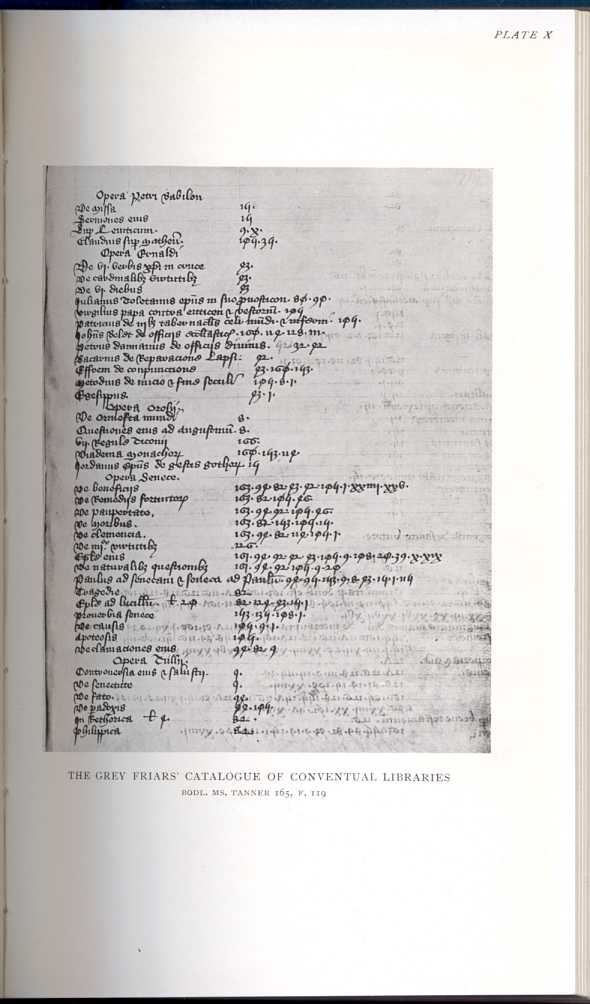 [Description: THE GREY FRIARS' CATALOGUE OF
CONVENTUAL LIBRARIES BODL. MS. TANNER 165 V. 119]
[Description: THE GREY FRIARS' CATALOGUE OF
CONVENTUAL LIBRARIES BODL. MS. TANNER 165 V. 119]
3. § III
We would fain fill in the outline we have given, for the friars and their book-loving ways are interesting. But enough has been written to show the origin and growth of libraries among the religious both of the abbeys and the friaries. Of the later days of monachism it is not so pleasant to write. The story has been well told many times, but no two writers, even in a broad and general way, let alone in detail, have read the facts alike. On the one hand it is urged that monachism became degenerate, both in reverence for spiritual affairs and in love of learning. Many monks, we are told, came to find more enjoyment in easy living than in ascetic and religious observances. Apart from the savage onslaughts in Piers Plowman, and the yarns of Layton and Legh, now quite discredited, we
An out-rydere, that lovede venerye; [hunting]
A manly man, to been an abbot able,
Ful many a deyntee hors hadde he in stable:
. . . . . . . . . . . . . . . . . . . . .
He was a lord ful fat and in good point [well-equipped]
His eyen stepe, and rollinge in his heed." [eyes bright]
And everich hostiler or gay tappestere."
No doubt also many a monk would argue with himself:—
Upon a book in cloistre alwey to poure
Or swinken with his handes, and laboure [toil]
As Austin bit?" [As St. Augustine bids]
And is into their bellies shoved,
By day and by night.
Liber Codex is neglected,
And with scornful hand rejected
Far out of their sight."
"And as if the simple monastic folk of modern times were deceived by a confusion of names, while Liber Pater is preferred to Liber Patrum, the study of the monks nowadays is in the emptying of cups and not the emending of books; to which they do not hesitate to add the wanton music of Timotheus, jealous of chastity, and thus the song of the merrymaker and not the chant of the mourner is become the office of the monks. Flocks and fleeces, crops and granaries, leeks and potherbs, drink and goblets, are nowadays the reading and study of the monks, except a few elect ones, in whom lingers not the image but some slight vestige of the fathers that preceded them."[3.54] Specific instances of neglect and worse are recorded. We have already mentioned the giving and selling of books by the monks of St. Albans to Richard de Bury. From the account books of Bolton Abbey it would appear that three books only were bought during forty years of the fourteenth century.[3.55] At St. Werburgh's, Chester, discipline was very lax. Two monks robbed the abbot of a book valued at £20, and of property valued at £100 or more, and stole from two of their brethren books and money (1409). About four years later one of the thieves was elected abbot, and his respect for learning may be gauged from the fact that in 1422 he was charged with not having maintained a scholar at Oxford or Cambridge for twelve years, although it was his duty to do so by the rules of his order. [3.56]
At Bury books were going astray in the first half of the fifteenth century. Abbot William Curteys (1429-45) issued an ordinance in which he declares books given out
But among so many houses some were bound to be ill-conducted. And it is important to remember that irregularities would be recorded oftener than more favourable facts. What had been usual would go unnoted; what was strange, and a departure from the highest standard of monachism, would be observed with regret by friends and dwelt on with spite by enemies. Although human
4. § IV
The whole truth about the later days of the monasteries will
never be known. Many of the original sources of our knowledge are
tainted with partisanship and religious rancour and flagrant dishonesty.
What does seem to be true is that in the fourteenth and fifteenth
centuries monastic influence grew slowly weaker, although the system may
not have been degenerate in itself. The cause is to be found in the very
prosperity of monachism, which brought to the religious houses wealth
and all its responsibilities. Wealth always imposes fetters, as every
rich man, from Seneca downwards, has declared with unctuous lamentation.
But
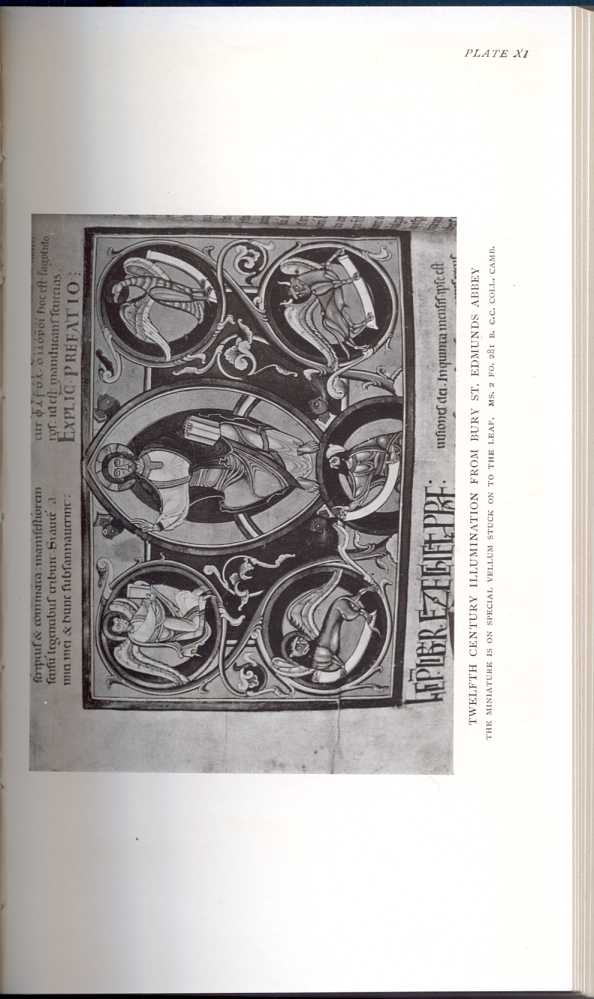 [Description: TWELFTH CENTURY ILLUMINATION FROM BURY
ST. EDMUNDS ABBEY THE MINIATURE IS ON SPECIAL VELLUM STUCK ON TO THE
LEAF. MS. 2 FO. 281 S. C.C. COLL. CAMB.]
[Description: TWELFTH CENTURY ILLUMINATION FROM BURY
ST. EDMUNDS ABBEY THE MINIATURE IS ON SPECIAL VELLUM STUCK ON TO THE
LEAF. MS. 2 FO. 281 S. C.C. COLL. CAMB.]
In the hastiness of the overthrow some conventual books were destroyed, or stolen, or sold off at low prices. In a few places damage was done even before the actual dissolution. At Christ Church, Canterbury, for example, the drunken servants of a royal commission carelessly brought about a fire, almost entirely destroying the
- Item, sold to Robert Doryngton, old boke, and a cofer in the library . . . . . ijs.
- Item, old bokes in the vestry, sold to the same Robert . . . . . viiid.
- Item, sold to Robert Whytgreve, a missale . . . . . viijd.
- Fyrst, sold to Mr. Whytgreve, a masse boke. . . . . xijd.
- Item, old bokes in the quyer. . . . . vjd.
- Item, a fryers masse boke, solde to Marke Wyrley . . . . . iiijd.[3.69]
Bale's statement is sadly borne out by the fate of the library of the Austin Friars of York. At one time this friary owned between six and seven hundred books. Now but five are known to remain. [3.70] "It is hardly open to doubt," writes Dr. James, "that nine-tenths of the books have ceased to exist. To be sure, it is no news to us that thousands, perhaps hundreds of thousands, of manuscripts were destroyed in the first half of the sixteenth century; but the truth comes heavily home when we are confronted with the actual figures of the loss sustained in one small corner of the field. We may fairly reckon that what
But the loss may be—and has been—exaggerated. In some instances a good part of a library was preserved. The Prior of Lanthony, a house in the outskirts of Gloucester, saved the books of his little community. From him they passed into the hands of one Theyer; later, possibly through Archbishop Bancroft, they found an ultimate resting-place in Lambeth Palace. During this interval many of them were perhaps lost or sold, but to-day some one hundred and thirty are known certainly to have come from Lanthony, or may be credited to that place on reasonably safe evidence.[3.72]
Then again Henry's myrmidons—to use the classic word—would be
unlikely to carry their vandalism too far. To do so, in view of the
great value of books, would bring them no profit. Knowing their
character, may we not reasonably assume that they sold as many books as
they could to make illicit gains?[3.73]
Sometimes they fell in love with their finds, as was natural. "Please it
you to understand," writes Thomas Bedyll, one of Henry VIII's
commissioners, "that in the reding of the muniments and chartors of the
house of Ramesey, I found a chartor of King Edgar, writen in a very
antiq Romane hand, hard to be red at the first sight, and light inowghe
after that a man found out vj or vij words and after compar letter to
letter. I am suer ye wold delight to see the same for the straingnes and
antiquite thereof.... I have seen also there a chartor of King Edward
writen affor the Conquest."[3.74]
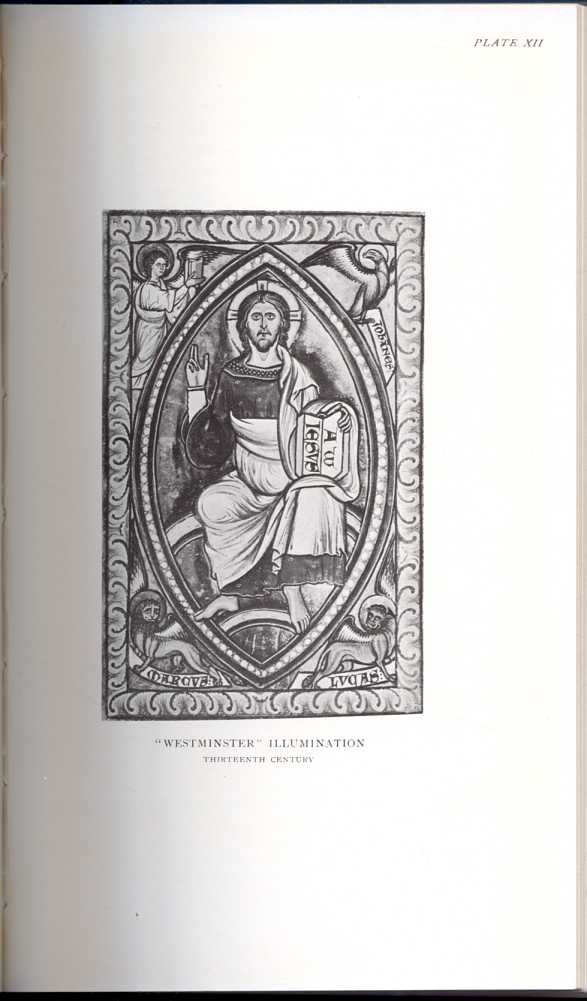 [Description: "WESTMINSTER" ILLUMINATION
THIRTEENTH CENTURY]
[Description: "WESTMINSTER" ILLUMINATION
THIRTEENTH CENTURY]
John Leland was one of those who saved books. Already he had been commissioned to examine the libraries of cathedrals, abbeys, priories, colleges, and other places wherein the records of antiquity were kept, when, observing with dismay the threatened loss of monastic treasures, he asked Cromwell to extend the commission to collecting books for the king's library. The Germans, he says, perceiving our "desidiousness" and negligence, were daily sending young scholars hither, who spoiled the books, and cut them out of libraries, and returned home and put them abroad as monuments of their own country.[3.75]
His request was granted in part, and he tells us he sent to London for the royal library the choicest volumes in St. Augustine's Abbey; but very few of these books now remain. [3.76] He had, he said, "conservid many good autors, the which otherwise had beene like to have perischid to no smaul incommodite of good letters, of the whiche parse remayne yn the moste magnificent libraries of yowr royal Palacis. Parte also remayne yn my custodye. Wherby I truste right shortely so to describe your most noble reaulme, and to publische the Majeste and the excellent actes of yowr progenitors."[3.77]
Robert Talbot, rector of Haversham, Berkshire (d. 1558), collected monastic manuscripts: the choicest of them he left to New College. A portreeve of Ipswich, named William Smart, came into possession of some hundred volumes from Bury Abbey library. In 1599 he gave them to Pembroke College, where they are now. [3.78] John Twyne, (d. 1581), schoolmaster and mayor of Canterbury, certainly once owned the fifteenth-century catalogue of the St. Augustine's Abbey library, and seems to have possessed many manuscripts. Both catalogue and manuscripts were
Archbishop Parker himself was assiduous in garnering books. "I have within my house, in wages," he writes to Lord Burleigh, in 1573, "drawers and cutters, painters, limners, writers and bookbinders." Again, "I toy out my time, partly with copying of books." He made a strenuous endeavour to recover as many of the monks' books as possible, using money and influence to this end; and accumulated an unusually large library, quite priceless in character. [3.80] Most of his choice books were presented to Corpus Christi College, Cambridge, and twenty-five of them to Cambridge University Library (1574). Dr. Montagu James, the leading authority on the provenance of Western manuscripts, has discovered or made suggestions as to the origin of nearly two hundred out of about three hundred and eighty.[3.81] Forty-seven are traced to Christ Church, Canterbury; twenty-six to St. Augustine's Abbey. Later Dr. James extended his work to identifying the manuscripts which were once in the Canterbury abbeys and in the priory of St. Martin at Dover. From the fragmentary Christ Church catalogue of 1170, Dr. James has identified two, and possibly six, manuscripts; from Henry Eastry's catalogue (14 cent.) of Christ Church books, he has identified
By making a similarly thorough investigation Dr. James has traced about three hundred and twenty-two manuscripts from Bury St. Edmunds.[3.83] Of the Westminster Abbey manuscripts it is difficult to say how many are extant, as the common medieval press marks are absent from the books of this house. But the presence of eleven manuscripts in the British Museum; two in Lambeth Palace; one at Sion College; three at the Bodleian, and five more in Oxford colleges; two at the Cambridge University Library, and two more in the colleges there; one at the Chetham Library, Manchester; and two at Trinity College, Dublin, well illustrate how the monastic books have been scattered since the Dissolution.[3.84] To these special examinations Dr. James has gradually added vastly to our knowledge of the provenance of manuscripts by his masterly series of catalogues of the ancient treasures of the Cambridge colleges, and he has proved to us that a considerable number of monastic books still survive.[3.85] Much more work of the same kind remains to be done; other labourers are
Most old English poems are preserved in unique manuscripts, sometimes not complete, but in fragments; two fragments, for example, were found in the bindings of other books.—Warton, ii. 7. In 1248, only four books in English were at Glastonbury, and they are described as old and useless.—John of G., 435; Ritson, i. 43. About fifty years later only seventeen such books were in the big library at Canterbury.—James (M. R.), 51. A striking illustration of the disuse of the vernacular among the religious is found in an Anglo-Saxon Gregory's Pastoral Care, which is copiously glossed in Latin, in two or three hands. This manuscript, now in Corpus Christi College, Cambridge, No. 12, came from Worcester Priory.—James 17, 33.
In an eleventh century manuscript in Trinity College Library, Cambridge (MS. B. 16, 44), is an inscription, perhaps by Lanfranc himself, recording that he brought it from Bec and gave it to Christ Church.
At the end of the manuscript of Cassian is written: "Hucusque ego Lanfrancus correxi." Hist. Litt. de la France, vii. 117. At the end of the Ambrose (Hexaemeron) the note reads, "Lanfrancus ego correxi."
Library of Ste. Genevieve, Paris, MS. E. 1. 17, in 40, fol. 61. The note reads: Quia autem apud Bequefort victualium copia erat, scriptores etiam ibi habebantur quorum opera ad nos in Normaniam mittebantur. Library, v. 2 (1893).
In the fine MS. Cott. Claud. E. iv. (Gesta Abatum) is a series of portrait miniatures of the abbots, and in most cases they are represented as reading or carrying books, or with books about them.
A lot of forty-nine, with prices attached, is given in Annales a J. Amund., ii. 268 et seq.
For St. Albans see Gesta Abbatum., i. 58, 70, 94, 106, 179, 184; ii. 200, 306, 363; iii. 389, 393
These works would be Latin translations based upon Arabic versions Opus Majus, iii. 66; Camb. Lit., i. 199; Gasquet3, 156.
Close roll, 10 Hen. III, m. 6 (3rd Sep.); Trivet, Annales, 243; Mon. Fr., i. 185; Stevenson, 76; O. H. S., Little, 57.
The catalogue is edited by Dr. M. R. James in Fasciculus Ioanni Willis Clark dicatus, 2-96.
Whitaker, Hist. of Craven, (1805), 330; another computus, discovered later, does not refer to books (ed. 1878).
A few volumes escaped: a copy of Basil's Commentary on Isaiah, presumably in Greek, and some others. "Among them must in all probability be reckoned the first copy of Homer whose presence can be definitely traced in England since the days of Theodore of Tarsus." Camb. Mod. Hist,, i. 598. Cp. James, li.
Laboryouse Journey and Serche of Johann Leylande for Englandes Antiquitees, by Bale, 1549. Cf. Strype, Parker (1711), 528.
Accounts of John Scudamore (king's receiver), detailing proceeds of sale of goods from Bordesley Abbey, and other monasteries. Cam. Soc., xxvi. 269, 271, 275.
C. A. S. 8vo. Publ., No. 33 (1900), Dr. James on MSS. in the Library of Lambeth Palace, pp. 1, 2, 6.
| CHAPTER III: LIBRARIES OF THE GREAT ABBEYS—BOOK-LOVERS AMONG THE
MENDICANTS—DISPERSAL OF MONKISH LIBRARIES Old English libraries; the making, collection and use of books during the middle ages | ||